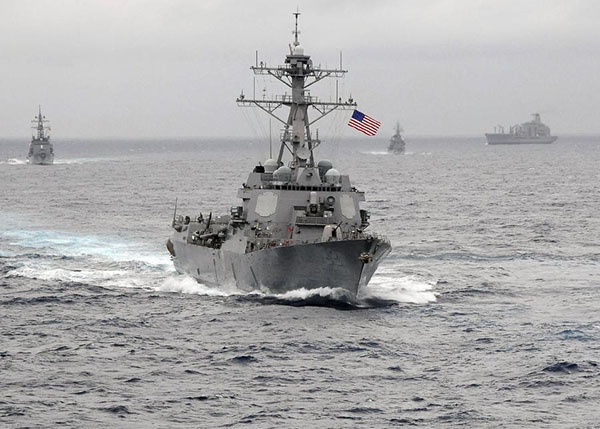Use 'quiet diplomacy' to resolve sea issue
Updated: 2015-11-12 08:07
By Zhang Tuosheng(China Daily)
|
||||||||
 |
|
The US Navy guided-missile destroyer USS Lassen sails in the Pacific Ocean in a November 2009 photo provided by the US Navy. [Photo/Agencies] |
The South China Sea is one of the busiest sea lanes in the world used by China, Japan, the Republic of Korea and many other countries, including the United States, and keeping it open is in the best interest of all. The shipping lane has never suffered disruptions despite the disputes among various countries over islands, reefs, and maritime rights and interests.
Still, the US has a fundamental disagreement with China over freedom of navigation. And the real reason for disagreement is the protracted close-range military reconnaissance and other operations by the US. Since US actions endanger China's national security, the latter is naturally opposed to them. Late last month, the US further intensified the disagreement over freedom of navigation by sending its warship to patrol the waters near the islands where China has carried out reclamation work.
On the handling of South China Sea-related issues, the White House, the US Department of State and the Department of Defense have some differing views. But the views of the Defense Department and the US Pacific Command seem the toughest.
Their belligerent views could be a symbolic stance to satisfy China bashers and get more budgetary funds. Or, they could signify their intention of turning the military operations in the South China Sea into a regular affair, gradually increasing their scale and intensity. Although both possibilities are provocative, the latter will greatly increase the risks of China-US frictions in the South China Sea. So, while waiting to see what exactly the US is after, China must prepare for a long-term struggle in case the US pursues the second path.
Compliance or non-compliance with the UN Convention on the Law of the Sea aside, the entry of the US warship into the waters near China's islands sends a strong negative signal: that the US considers China an adversary or even a potential enemy.
The disputes in the South China Sea are rather complicated. China has disputes over islands, reefs and/or maritime rights and interests with five Southeast Asian countries (with Indonesia, it only has a dispute over maritime rights or interests). Given the situation, China has not set its territorial sea base points or drawn the baseline for islands and reefs in the South China Sea; they remain ambiguous to a certain extent. This shows China has been exercising utmost restraint and sincerely hopes to resolve the disputes through peaceful dialogue.
- China responds to Pentagon chief's visit to aircraft carrier in South China Sea
- Key points of Xi's remarks on South China Sea in Singapore lecture
- US act escalates tensions in South China Sea
- South China Sea territories must be secured
- South China Sea ruling 'null and void', says ministry
- Historical evidence of China's sovereignty over the South China Sea
- US provocative act in South China Sea
- China warns US of 'eventualities' in South China Sea
- US violating international law by making waves in South China Sea
- US should change tack in South China Sea
- Global health entering new era: WHO chief
- Brazil's planning minister steps aside after recordings revelation
- Vietnam, US adopt joint statement on advancing comprehensive partnership
- European border closures 'inhumane': UN refugee agency
- Japan's foreign minister calls A-bombings extremely regrettable
- Fukushima impact unprecedented for oceans: US expert

 Stars of Lijiang River: Elderly brothers with white beards
Stars of Lijiang River: Elderly brothers with white beards
 Wealthy Chinese children paying money to learn British manners
Wealthy Chinese children paying money to learn British manners
 Military-style wedding: Fighter jets, grooms in dashing uniforms
Military-style wedding: Fighter jets, grooms in dashing uniforms
 Striking photos around the world: May 16 - May 22
Striking photos around the world: May 16 - May 22
 Robots help elderly in nursing home in east China
Robots help elderly in nursing home in east China
 Hanging in the air: Chongqing holds rescue drill
Hanging in the air: Chongqing holds rescue drill
 2.1-ton tofu finishes in two hours in central China
2.1-ton tofu finishes in two hours in central China
 Six things you may not know about Grain Buds
Six things you may not know about Grain Buds
Most Viewed
Editor's Picks

|

|

|

|

|

|
Today's Top News
Liang avoids jail in shooting death
China's finance minister addresses ratings downgrade
Duke alumni visit Chinese Embassy
Marriott unlikely to top Anbang offer for Starwood: Observers
Chinese biopharma debuts on Nasdaq
What ends Jeb Bush's White House hopes
Investigation for Nicolas's campaign
Will US-ASEAN meeting be good for region?
US Weekly

|

|








